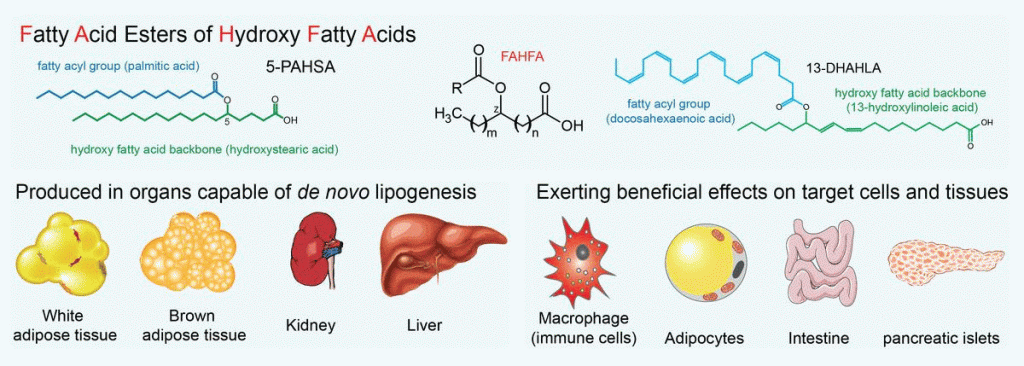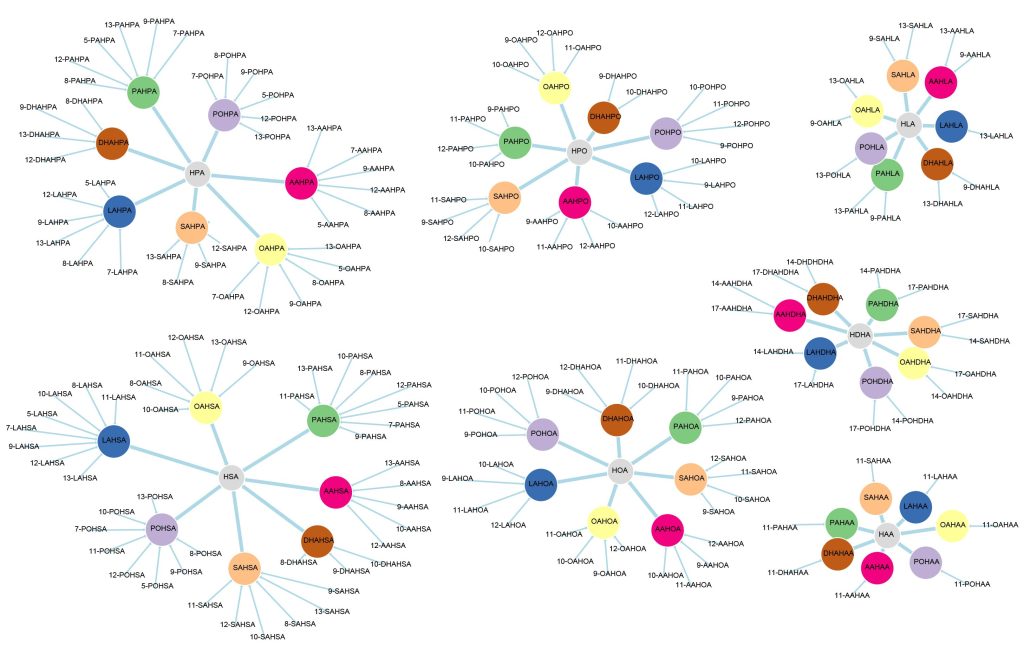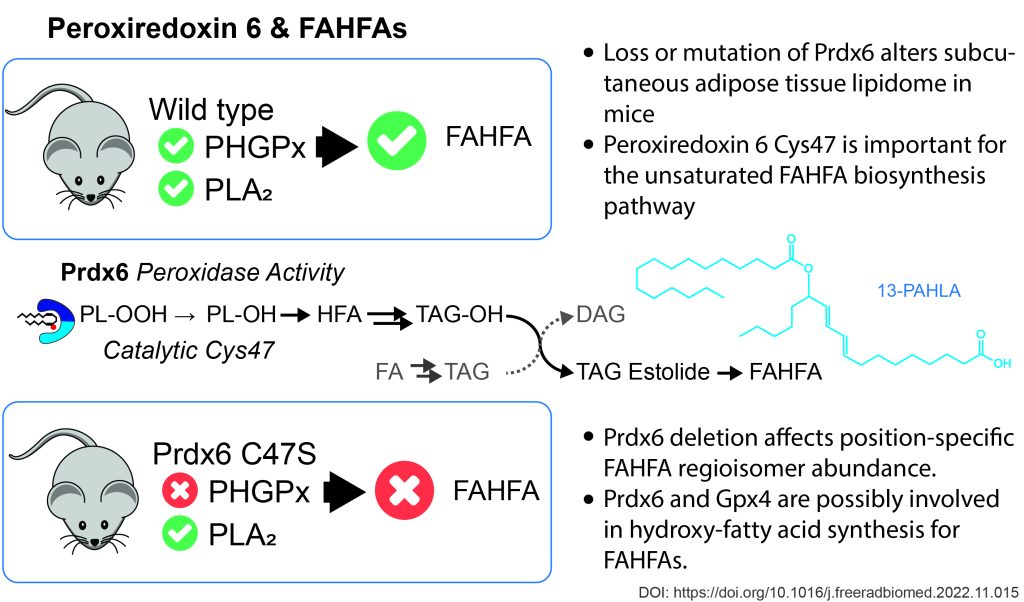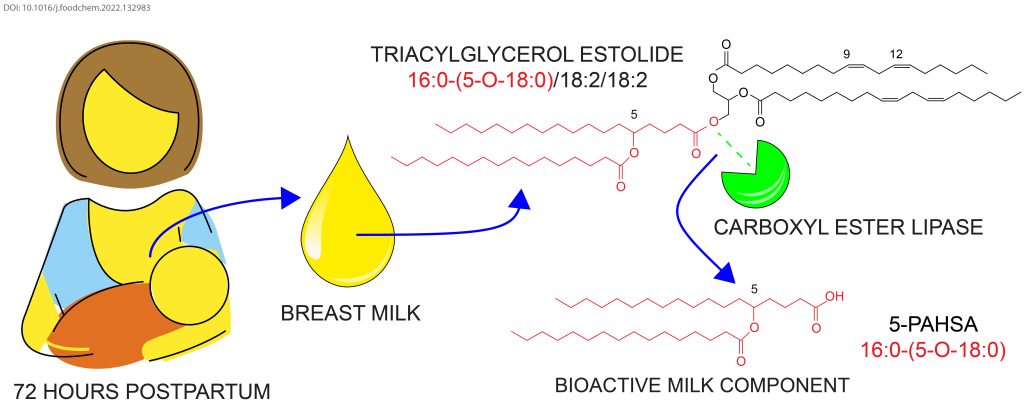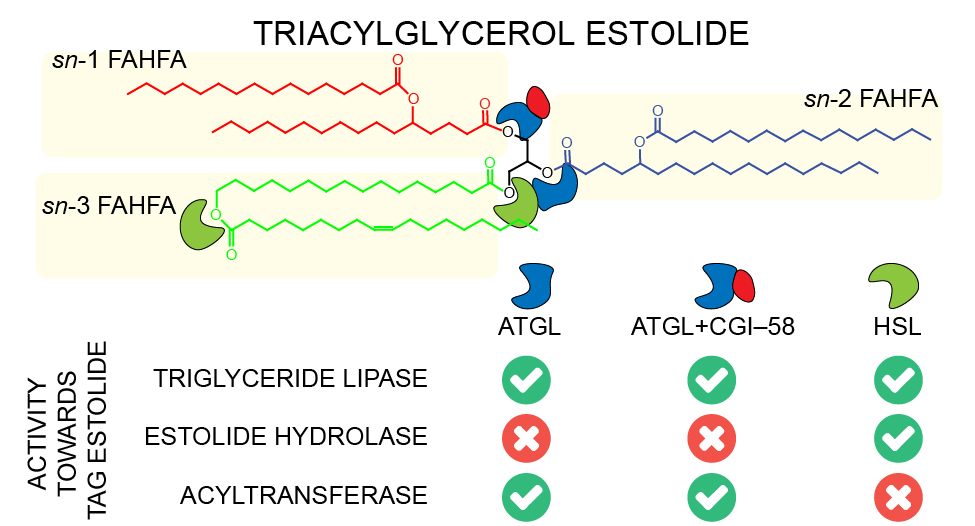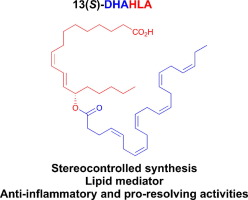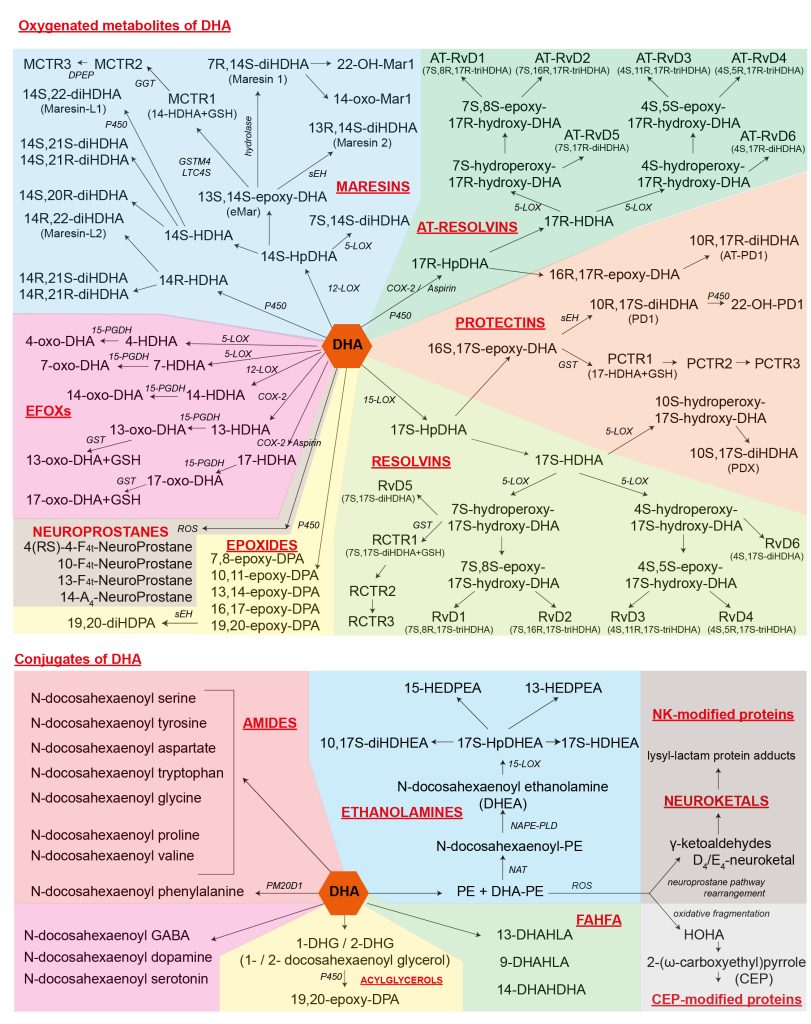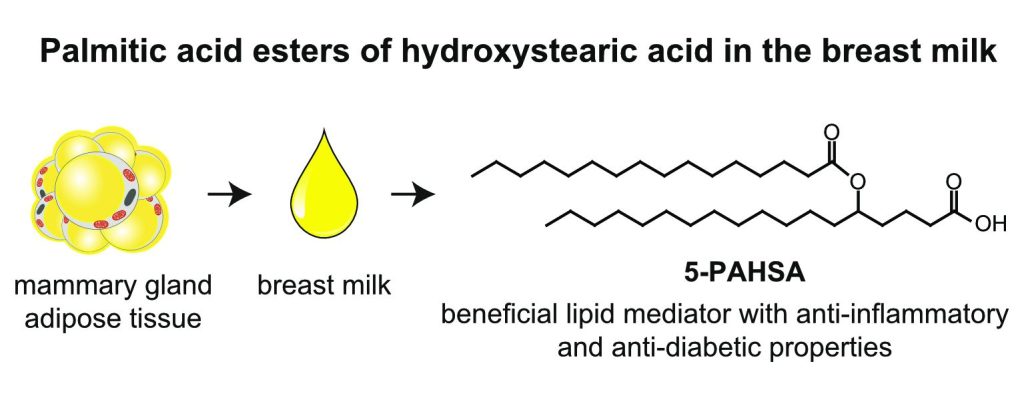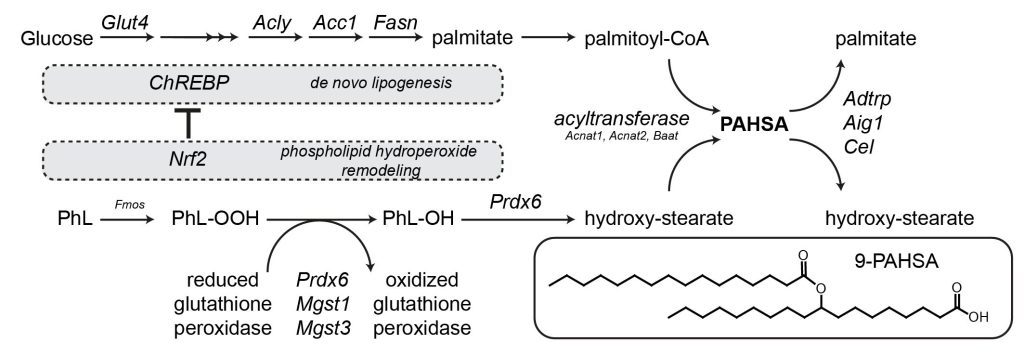They consist of a fatty acid (e.g. palmitic acid, PA) esterified to the hydroxyl group of a hydroxy fatty acid (e.g. hydroxystearic acid, HSA), abbreviated as PAHSA. The position of the branching carbon defines a regioisomer (e.g. 5-PAHSA). There are several regioisomer families derived from palmitic, palmitoleic, stearic, oleic, linoleic, and docosahexaenoic acid with tissue-specific distribution documented so far [1-4, 6, 7]. Adipose tissue represents a major site of FAHFAs synthesis [1, 2], but the biosynthetic enzymes involved are unknown [11]. Serine hydrolase carboxyl ester lipase [8] and threonine hydrolases [9] were identified as FAHFA-metabolizing enzymes. In humans, FAHFAs were detected in the serum, breast milk, meconium, and adipose tissues [1, 2, 10].
Network representation of FAHFA families linked according to the hydroxy-backbone and colored according to the esterified fatty acid [13][14].
Our hypothesis is that novel FAHFAs derived from omega-3 PUFA, with anti-inflammatory properties, could be found in mice and humans and that they can beneficially affect adipose tissue metabolism in obesity, especially low-grade inflammation. We are also interested in FAHFA metabolic pathways, which seem to be as complex as eicosanoid-related pathways. Using experiments in cell cultures, mice and humans we explore the structures, effects on WAT inflammation, WAT glucose tolerance and molecular mechanisms of signaling of these new lipokines. Our results present a significant advance in research of the mechanisms connecting inflammation, metabolism, and nutritional lipids.
Our publications:
► Oleksandr Kozlov, Miroslav Lísa, Martin Riecan, Ondrej Kuda
Chiral supercritical fluid chromatography-mass spectrometry with liquid chromatography fractionation for the characterization of enantiomeric composition of fatty acid esters of hydroxy fatty acids
Anal Chim Acta. 2025 Apr 1:1345:343735. DOI: https://doi.org/10.1016/j.aca.2025.343735
- First report of chiral SFC separation of fatty acid esters of hydroxy fatty acids..
- Offline 2D approach with LC fractionation of regioisomers and chiral SFC-MS of fractions.
- Characterization of the enantiomeric composition of biological samples.
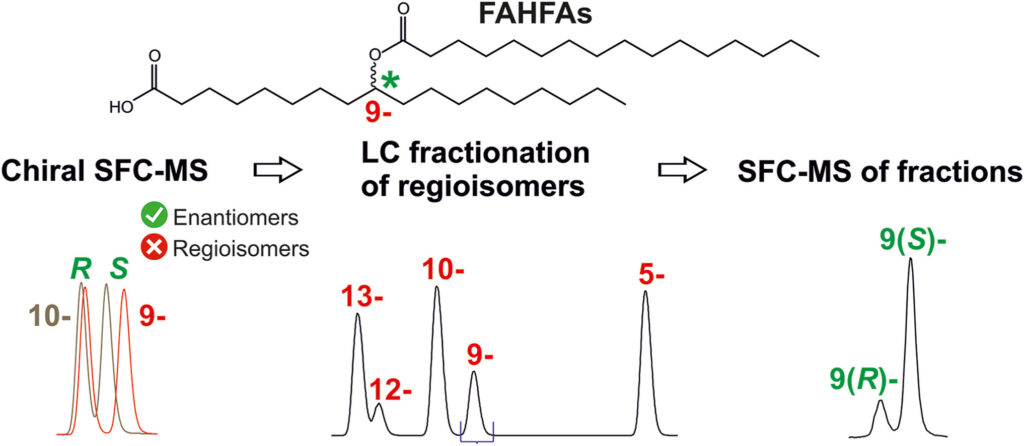
► Veronika Paluchova, Tomas Cajka, Thierry Durand, Claire Vigor, Chandra Dodia, Shampa Chatterjee, Aron B. Fisher, Ondrej Kuda✉
The role of peroxiredoxin 6 in biosynthesis of FAHFAs
Free Radical Biology and Medicine, Volume 193, Part 2, 20 November 2022, Pages 787-794. DOI https://doi.org/10.1016/j.freeradbiomed.2022.11.015
Peroxiredoxin 6 (Prdx6) is a multifunctional enzyme, a unique member of the peroxiredoxin family……
- Loss or mutation of Prdx6 alters subcutaneous adipose tissue lipidome in mice.
- Peroxiredoxin 6 Cys47 is important for the unsaturated FAHFA synthesis pathway.
- Prdx6 deletion affects position-specific FAHFA regioisomer abundance.
- Prdx6 and Gpx4 are possibly involved in hydroxy-fatty acid synthesis for FAHFAs.
- Prdx6 protein model supports phospholipid binding over two monomers.
► Kristyna Brejchova, Veronika Paluchova, Marie Brezinova, Tomas Cajka, Laurence Balas, Thierry Durand, Marcela Krizova, Zbynek Stranak, Ondrej Kuda✉
Triacylglycerols containing branched palmitic acid ester of hydroxystearic acid (PAHSA) are present in the breast milk and hydrolyzed by carboxyl ester lipase
Food Chemistry, Volume 388, 15 September 2022, 132983. DOI https://doi.org/10.1016/j.foodchem.2022.132983
Breast milk is a complex mixture containing underexplored bioactive lipids…..
- Effect of preterm birth (PB) or caesarean section (CS) on milk metabolome.
- Colostrum levels of 5-PAHSA were negatively affected by PB and CS.
- FAHFA-containing triacylglycerols are substrates of carboxyl ester lipase in milk.
- 5-PAHSA-containing lipids are resistant to carboxyl ester lipase hydrolysis.
► Martin Riecan, Veronika Paluchova, Magno Lopes, Kristyna Brejchova and Ondrej Kuda✉
Branched and linear fatty acid esters of hydroxy fatty acids (FAHFAs) relevant to human health
Pharmacology & Therapeutics, 2022 Mar;231:107972. DOI https://doi.org/10.1016/j.pharmthera.2021.107972
Fatty acid esters of hydroxy fatty acids (FAHFAs) represent a complex lipid class…..
Free fulltext till October 23, 2021
- Two structurally and functionally distinct FAHFA superfamilies are recognized based on the position of the estolide bond: omega-FAHFAs and in-chain branched FAHFAs.
- We propose a theoretical involvement of cytochrome P450 enzymes in the generation and degradation of saturated HFA backbones.
- And present an overview of small-molecule inhibitors used in FAHFA research
► Kristyna Brejchova, Franz Peter Walter Radner, Laurence Balas, Veronika Paluchova, Tomas Cajka, Hana Chodounska, Eva Kudova, Margarita Schratter, Renate Schreiber, Thierry Durand, Rudolf Zechner, and Ondrej Kuda✉
Distinct roles of adipose triglyceride lipase and hormone-sensitive lipase in the catabolism of triacylglycerol estolides
PNAS January 12, 2021 118 (2) e2020999118. DOI https://doi.org/10.1073/pnas.2020999118
- Fat mass is controlled by the balance of triacylglycerol (TAG) degradation and synthesis. Adipose triglyceride lipase (ATGL) and hormone-sensitive lipase (HSL) are key players in TAG catabolism providing fatty acids (FAs) as energy substrates and metabolic intermediates.
- Here, we show that ATGL and HSL metabolize TAGs containing antidiabetic lipid mediators (FA esters of hydroxy FAs), distinctly controlling the release of bioactive lipids.
- Our paper connects lipolysis-mediated TAG metabolism with the regulation of antidiabetic signaling lipids.
- Mass spectra of TAG estolide standards are available from MassBank of North America (MoNA)
► Kristyna Brejchova, Laurence Balas, Veronika Paluchova, Marie Brezinova, Thierry Durand, Ondrej Kuda✉
Understanding FAHFAs: From Structure to Metabolic Regulation
Progress in Lipid Research, Volume 79, July 2020, 101053. DOI https://doi.org/10.1016/j.plipres.2020.101053 fulltext PDF link
- Review of total syntheses of FAHFAs
- FAHFA nomenclature & analytical procedures
- Metabolism – synthesis and degradation
- Biological effects on target organs
- FAHFA-ome in human adipose tissue – network of 583 FAHFAs from 21 families
► Veronika Paluchova, Anders Vik, Tomas Cajka, Marie Brezinova, Kristyna Brejchova, Viktor Bugajev, Lubica Draberova, Petr Draber, Jana Buresova, Petra Kroupova, Kristina Bardova, Martin Rossmeisl, Jan Kopecky, Trond Vidar Hansen, Ondrej Kuda✉
Triacylglycerol-rich oils of marine origin are optimal nutrients for induction of polyunsaturated docosahexaenoic acid ester of hydroxy linoleic acid (13-DHAHLA) with anti-inflammatory properties in mice.
Molecular Nutrition and Food Research, in press DOI https://doi.org/10.1002/mnfr.201901238
Scope Docosahexaenoic acid ester of hydroxy linoleic acid (DHAHLA) is a bioactive ……
- 13-DHAHLA is an anti-inflammatory lipid mediator.
- The authors investigate DHA-rich marine oils as potential nutritional sources of 13-DHAHLA precursors and explore anti-inflammatory properties of the bioactive lipid.
- The results suggest that triacylglycerol-based marine oils are superior to marine phospholipids and wax esters in the ability to increase levels of 13-DHAHLA in circulation.
- Both 13(S)- and 13(R)-DHAHLA inhibited antigen and PGE2-induced chemotaxis and degranulation of mast cells.
► Melha Benlebna, Laurence Balas, Béatrice Bonafos, Laurence Pessemesse, Gilles Fouret, Claire Vigor, Sylvie Gaillet, Jacques Grober, Florence Bernex, Jean François Landrier, Ondrej Kuda, Thierry Durand, Charles Coudray, François Casas, Christine Feillet-Coudray
Long-term intake of 9-PAHPA or 9-OAHPA modulates favorably the basal metabolism and exerts an insulin sensitizing effect in obesogenic diet-fed mice.
European Journal of Nutrition, 2020 in press DOI https://doi.org/10.1007/s00394-020-02391-1
Purpose Fatty acid esters of hydroxy fatty acids (FAHFAs) are a large family of ….
- 9-PAHPA and 9-OAHPA increased insulin sensitivity in C57Bl/6J obese mice.
- 9-PAHPA and 9-OAHPA did not affect liver metabolism.
► Melha Benlebna, Laurence Balas, Beatrice Bonafos, Laurence Pessemesse, Claire Vigor, Jacques Grober, Florence Bernex, Gilles Fouret, Veronika Paluchova, Sylvie Gaillet, Jean Francois Landrier, Ondrej Kuda, Thierry Durand, Charles Coudray, François Casas, Christine Feillet-Coudray
Long-term high dietary intake of 9-PAHPA or 9-OAHPA increases basal metabolism and insulin sensitivity but disrupts liver homeostasis in healthy mice.
Journal of Nutritional Biochemistry, Volume 79, May 2020, 108361 DOI https://doi.org/10.1016/j.jnutbio.2020.108361
Branched fatty acid esters of hydroxy fatty acids (FAHFAs) are …..
- 9-PAHPA and 9-OAHPA are two branched fatty acid esters of hydroxy fatty acids (FAHFAs)
- These both FAHFAs increased basal metabolism in C57Bl/6J healthy mice
- 9-PAHPA and 9-OAHPA increased insulin sensitivity in C57Bl/6J healthy mice
- 9-PAHPA and 9-OAHPA induced hepatic steatosis and fibrosis in some C57Bl/6J mice
► Veronika Paluchova, Marina Oseeva, Marie Brezinova, Tomas Cajka, Kristina Bardova, Katerina Adamcova, Petr Zacek, Kristyna Brejchova, Laurence Balas, Hana Chodounska, Eva Kudova, Renate Schreiber, Rudolf Zechner, Thierry Durand, Martin Rossmeisl, Nada A. Abumrad, Jan Kopecky, Ondrej Kuda✉
Lipokine 5-PAHSA is Regulated by Adipose Triglyceride Lipase and Primes Adipocytes for de novo Lipogenesis in Mice.
Diabetes. 2020 Mar;69(3):300-312. DOI https://doi.org/10.2337/db19-0494
Branched esters of palmitic acid and hydroxy-stearic acid (PAHSA) are anti-inflammatory …….
► Marie Brezinova, Tomas Cajka, Marina Oseeva, Marek Stepan, Klara Dadova, Lenka Rossmeislova, Milos Matous, Michaela Siklova, Martin Rossmeisl, Ondrej Kuda✉
Exercise training induces insulin-sensitizing PAHSAs in adipose tissue of elderly women.
Biochimica et Biophysica Acta (BBA) – Molecular and Cell Biology of Lipids, 1865 (2020) 158576; online 16 November 2019; DOI https://doi.org/10.1016/j.bbalip.2019.158576
- Exercise training stimulates beneficial changes in adipose tissue of elderly women.
- Exercise stimulates production of insulin-sensitizing lipid mediators PAHSAs.
- Insulin sensitivity is associated with short chain TAGs in adipose tissue.
- Ether lipids and TAG estolides were detected in serum and adipose tissue samples.
► Anders Vik, Trond Vidar Hansen, Ondrej Kuda
Synthesis of both enantiomers of the docosahexaenoic acid ester of 13-hydroxyoctadecadienoic acid (13-DHAHLA).
Tetrahedron Letters 60 (2019), 1 November 2019, 151331; DOI https://doi.org/10.1016/j.tetlet.2019.151331
Organic synthesis of 13(S)-DHAHLA and 13(R)-DHAHLA
Kuda O, Brezinova M, Rombaldova M, Slavikova B, Posta M, Beier P, Janovska P, Veleba J, Kopecky J Jr, Kudova E, Pelikanova T, Kopecky J. Docosahexaenoic acid-derived fatty acid esters of hydroxy fatty acids (FAHFAs) with anti-inflammatory properties. Diabetes Sep 2016, 65 (9) 2580-2590; DOI: 10.2337/db16-0385
http://diabetes.diabetesjournals.org/content/65/9/2580
http://diabetes.diabetesjournals.org/content/65/11/3516.2 erratum – an incorrect version of the Supplementary Data was erroneously posted online and has been replaced with the correct version.
Chronický zánět přispívá ke vzniku cukrovky, stejně jako kardiovaskulárních, střevních i některých mozkových onemocnění. Tuky z mořských ryb napomáhají v prevenci zánětlivých onemocnění.
Omega-3 polyunsaturated fatty acids (omega-3) of marine origin alleviate inflammation, while having favorable metabolic effects. Omega-3 reduce the risk of development of cardiovascular disorders that are linked to obesity and type 2 diabetes, and also improve lipid metabolism. A complex research of omega-3-related mechanisms of action in mouse models of obesity at the Institute of Physiology CAS, clinical research on obese patients with type 2 diabetes in the Institute for Clinical and Experimental Medicine, and a collaboration with the Institute of Organic Chemistry and Biochemistry CAS led to the identification of structures of novel signaling molecules of lipid origin – esters of fatty acids and hydroxyl-fatty acids (FAHFA) – derived from docosahexaenoic acid (DHA): 13-DHAHLA, 9-DHAHLA a 14-DHAHDHA. These molecules, which are synthesized by adipose cells and exert anti-inflammatory effects, were detected in the serum and adipose tissue of both obese mice and diabetic patients following dietary intervention with omega-3. These newly discovered molecules, which can be endogenously synthesized when eating an appropriate diet, are involved in the beneficial health effects of omega-3 and have the potential for their wide use in the prevention and treatment of severe diseases.
Chronic low-grade inflammation contributes to the development of diabetes, as well as cardiovascular, gastrointestinal and certain brain disorders. Lipids of marine origin help to prevent inflammatory diseases.
Kuda O. Bioactive metabolites of docosahexaenoic acid. Biochimie. Jan 2017, DOI: 10.1016/j.biochi.2017.01.002
http://www.sciencedirect.com/science/article/pii/S0300908416302218
Přehled bioaktivních metabolitů DHA. Schema k tisku v JPEG
Brezinova M, Kuda O, Hansikova J, Rombaldova M, Balsa L, Bardova K, Durand T, Rossmeisl M, Cerna M, Stranak Z, Kopecky J. Levels of palmitic acid ester of hydroxystearic acid (PAHSA) are reduced in the breast milk of obese mothers. BBA – Molecular and Cell Biology of Lipids 1863 (2018) 126–131; https://doi.org/10.1016/j.bbalip.2017.11.004
fulltext share link till 01/08/2018
Ondrej Kuda✉, Marie Brezinova, Jan Silhavy, Vladimir Landa, Vaclav Zidek, Chandra Dodia, Franziska Kreuchwig, Marek Vrbacky, Laurence Balas, Thierry Durand, Norbert Hübner, Aron B. Fisher, Jan Kopecky and Michal Pravenec Nrf2-mediated Antioxidant Defense and Peroxiredoxin 6 are Linked to Biosynthesis of Palmitic Acid Ester of 9-Hydroxystearic Acid. Diabetes 2018 Mar; db171087.; DOI https://doi.org/10.2337/db17-1087
Comprehensive lipidomic analysis of rat white adipose tissue samples identified ~160 FAHFA regioisomers and QTL analysis highlighted several positional candidate genes in PAHSA metabolism. The results indicate that the synthesis of PAHSAs via carbohydrate-responsive element-binding protein (ChREBP)-driven de novo lipogenesis is linked to the adaptive antioxidant system and the remodelling of phospholipid hydroperoxides.
► Ondrej Kuda✉ On the Complexity of PAHSA Research. Cell Metabolism 2018, Sep 20; DOI https://doi.org/10.1016/j.cmet.2018.09.006
Comments on the methodological and conceptual problems when working with FAHFAs.
fulltext at https://www.cell.com/cell-metabolism/pdf/S1550-4131(18)30571-0.pdf
free fulltext link https://authors.elsevier.com/a/1Xq8i5WXUlA-Mk

